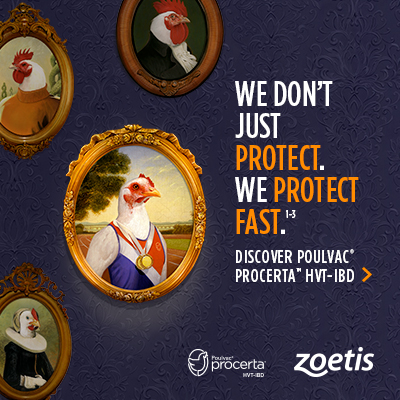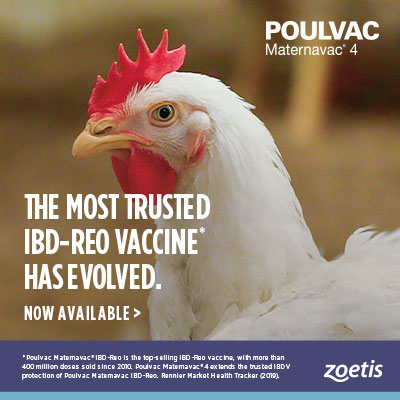New vaccine simplifies IBDV vaccination; provides effective early pullet protection
An interview with John Brown, DVM, senior technical services veterinarian and layer specialist, Zoetis
Q: In 2021, Zoetis introduced Poulvac® Procerta™ HVT-IBD, a recombinant vector vaccine that protects against infectious bursal disease viruses (IBDV) and Marek’s disease. How will the vaccine benefit the egg-layer producers?
JB: The big advantage is that Poulvac Procerta HVT-IBD provides immunity against classic,1 very virulent IBDV (vvIBDV)2 and variant3 IBDVs at about the same time IBDV maternal antibodies (MABs) start to decline. Immunity from recombinant IBDV vaccines may not kick in before MABs decline, which can leave a gap in immunity.4 The new vaccine can help eliminate that gap.
We also expect the new vaccine to greatly simplify the IBDV vaccination protocol for producers still protecting flocks with live IBDV vaccines. In many cases, it will eliminate the need for repeat vaccination of layer pullets.
Q: How can the vaccine simplify IBDV pullet vaccination?
JB: To fill large pullet houses, hatcheries have to source birds from different breeder flocks that often differ in age. MABs that pullets acquire from old breeders tend to be lower while those from young breeders tend to be higher.
When you put all those birds together, there’s a lot of variation. To cover the gamut of MAB levels, some producers administer live IBDV vaccines multiple times — at 14, 28 and 35 days is typical. But even then, some chicks may not be protected.
In contrast, one subcutaneous dose of Poulvac Procerta HVT-IBD can in most instances replace the need for live IBDV vaccines in layer pullets because it’s been demonstrated to be effective whether there are MABs or not.5,6
Q: If a producer wants to use a recombinant instead of live vaccines, why choose Poulvac Procerta HVT-IBD?
JB: Our team of scientists has conducted rigorous challenge studies. In one of them, a single subcutaneous dose of Poulvac Procerta HVT-IBD at hatch provided 98% protection against a classic virulent IBDV challenge at 14 days of age.7 In a separate study, 92% of birds that received the new vaccine were protected after a challenge with classic IBDV at 21 days of age.8
Q: Does Poulvac Procerta HVT-IBD protect against vvIBDV and variants?
JB: It does. When our scientists vaccinated birds with the new vaccine at hatch and then challenged them with a vvIBDV at 12 days of age, Poulvac Procerta HVT-IBD provided 90% protection. Among unvaccinated controls that were challenged, mortality was 70% compared to 0% among birds vaccinated with the new recombinant vaccine.9
In studies, Poulvac Procerta HVT-IBD protected as early as 14 days against the most prevalent AL2 family of IBDV variants.10,11
Q: Why is early protection important?
JB: IBDV infection tends to affect young birds more severely than older ones — so it’s important to protect the weakest birds (low MABs) in the flock as early as you can. The most worrisome result is immunosuppression leading to poor flock uniformity and then poor performance in the lay house. Immunosuppression also makes birds vulnerable to a host of secondary infections.
I’ve seen cases where IBDV-infected birds developed infectious bronchitis, coccidial issues, Escherichia coli or Salmonella. The losses can really add up. Pullets with immunosuppression may also not respond well to other necessary vaccines.
Q: What is it about Poulvac Procerta HVT-IBD that enables it to provide early protection?
JB: As with many other recombinant vaccines, the backbone of Poulvac Procerta HVT-IBD is a herpesvirus of turkey (HVT), which protects against Marek’s disease. HVT recombinant vaccines are also widely known to be safe. We believe what differentiates our vaccine is fast replication of the HVT vector we used coupled with strong expression of the IBDV gene inserted into the backbone. Those attributes are largely responsible for the vaccine’s ability to provide effective early immunity.
Q: Is protection from the new vaccine lasting?
JB: A duration-of-immunity study showed that at 63 days of age, birds were 100% protected against standard IBDV.12 By that age, IBDV isn’t the great concern it is in younger layers.
Q: Are there any circumstances when a live IBDV vaccine is still needed in pullets that have received the new recombinant vaccine?
JB: If there’s a very high field challenge and especially if MABs are low, vaccination with a live IBDV vaccine might be indicated after use of any of the recombinant IBDV vaccines. Bursine®-2 would be a good live-vaccine option.
Q: How would you sum up the advantages of Poulvac Procerta HVT-IBD?
JB: By reducing or eliminating the need for live IBDV vaccines in pullets, Poulvac Procerta HVT-IBD makes IBDV control a lot easier and reduces stress on birds since they’ll need fewer vaccinations. And by providing effective early immunity, there’s less chance for IBDV infection leading to immunosuppression and costly secondary problems. Overall, I’d say this vaccine provides the layer industry with a valuable new tool for controlling IBDV.
1 Data on file. Study Report No. B815R-US-19-B20. Zoetis LLC.
2 Data on file. Study Report No. B812R-US-19-B42. Zoetis LLC.
3 Data on file. Study Report No. B815W-US-19-A92. Zoetis LLC.
4 Gelb J, et al. Efficacy of Recombinant HVT-IBD Vaccines Administered to Broiler Chicks from a Single Breeder Flock at 30 and 60 Weeks of Age. Avian Dis. 2016 Sep;60(3):603-12.
5 Data on file. Study Report No. B818R-US-19-B94. Zoetis LLC.
6 Data on file. Study Report No. B815W-US-19-A92. Zoetis LLC.
7 Data on file. Study Report No. B815R-US-19-B20. Zoetis LLC.
8 Data on file. Study Report No. B812W-US-18-919. Zoetis LLC.
9 Data on file. Study Report No. B812R-US-19-B42. Zoetis LLC.
10 Cookson K, Featherson S, Barker A, Schaeffer J. A survey of wild type IBDV isolated from broiler flocks in the United States since 2014. 2020 International Poultry Scientific Forum, Atlanta, GA.
11 Data on file. Study Report No. B815R-US-19-B80. Zoetis LLC.
12 Data on file. Study Report No. B814R-US-19-B15. Zoetis LLC.
TOOLBOX, Issue 25
Toolbox is a series of interviews with veterinarians and other technical specialists about their experiences managing antimicrobials, vaccines and other tools for poultry health. It is produced by the editors of Poultry Health Today on behalf of the US Poultry Business of Zoetis.
BIO-00299
Feb 2021
Posted on March 18, 2021














